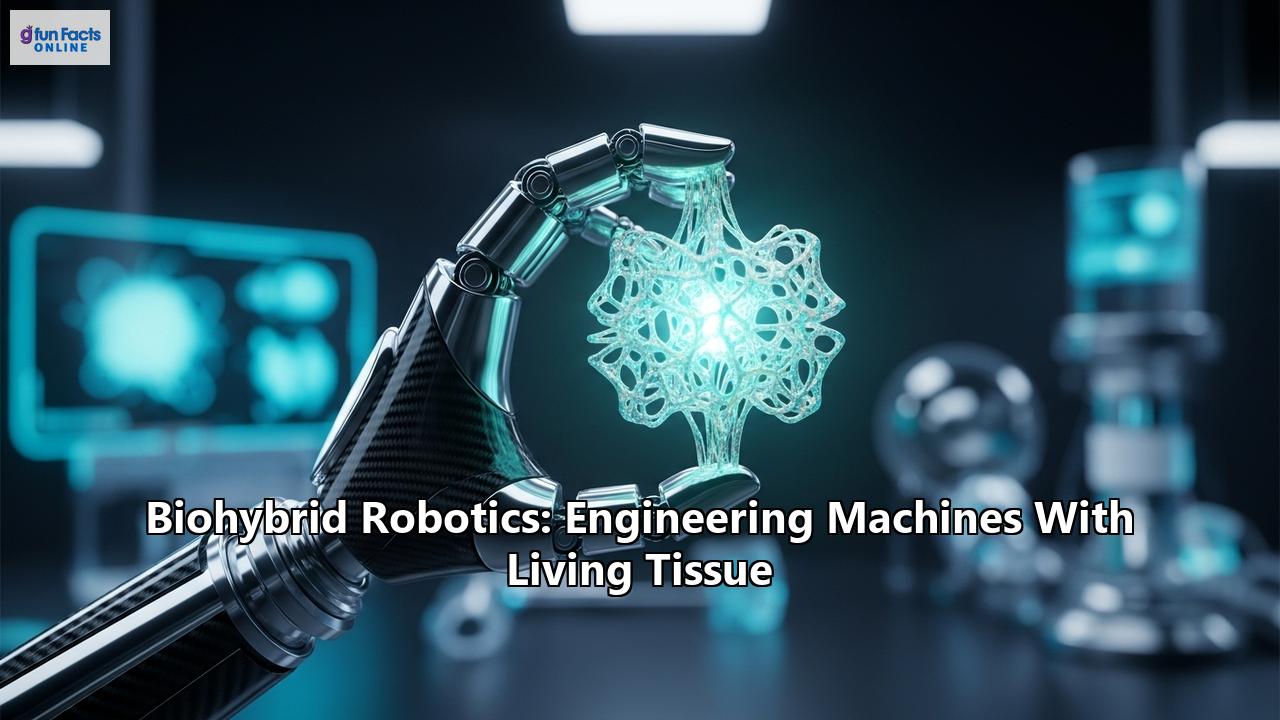of neurons and the development of more sophisticated neural interfaces will be a major focus of future research. This will pave the way for biohybrid robots with advanced sensory capabilities, the ability to learn and adapt to their environment, and even a form of "bio-intelligence" that allows for complex decision-making.
- Sustainable and Autonomous Power Sources: The development of sustainable and autonomous power sources is critical for the long-term viability of biohybrid robots. Future research will explore new ways to power these machines using biological fuel sources, such as glucose or even light, reducing their dependence on traditional batteries and making them truly self-sufficient.
- From the Lab to the Real World: The ultimate goal of biohybrid robotics is to create machines that can function in the real world. This will require developing systems that are more robust, adaptable, and able to withstand the rigors of complex and uncontrolled environments.
A Vision of the Future: The Long-Term Impact
The long-term vision for biohybrid robotics is one where the lines between biology and technology become increasingly blurred, leading to a new era of "living machines" that are fully integrated into our society.
- Personalized and Regenerative Medicine: In the future, it may be possible to grow replacement organs or limbs for patients using their own cells, creating biohybrid implants that are perfectly matched to their bodies. Tiny bio-bots could patrol our bodies, constantly monitoring our health and repairing damage before it becomes a serious problem.
- A Symbiotic Relationship with Nature: Biohybrid robots could become our partners in environmental stewardship, working alongside us to clean up pollution, restore damaged ecosystems, and monitor the health of our planet. Their biodegradable nature would ensure that they do not become a new source of pollution.
- Redefining the Human-Machine Interface: As biohybrid technologies advance, we may see the development of new types of human-machine interfaces that allow for a more direct and intuitive connection between our minds and our machines. This could lead to a future where we can control a wide range of devices with our thoughts, from prosthetic limbs to complex robotic systems.
The Ethical Imperative
As we stand on the cusp of this new technological revolution, it is more important than ever to consider the ethical implications of our creations. The development of machines that are part living and part artificial forces us to confront fundamental questions about the nature of life, consciousness, and our responsibilities as creators.
We must engage in a broad and inclusive dialogue about the potential risks and benefits of this technology, establishing clear ethical guidelines and regulatory frameworks to ensure that it is developed and used responsibly. The future of biohybrid robotics is not just a scientific and engineering challenge; it is also a profound ethical one.
In conclusion, the journey into the world of biohybrid robotics is a journey into the very heart of what it means to be alive. It is a field that is constantly pushing the boundaries of our knowledge, challenging our assumptions, and opening up new possibilities for the future. The "living machines" that are emerging from laboratories around the world are more than just technological marvels; they are a testament to the power of human ingenuity and a glimpse into a future where the synergy between biology and technology creates a world that is more sustainable, more humane, and more alive than ever before.
Reference:
- https://thinkrobotics.com/blogs/learn/biohybrid-robots-merging-biology-with-robotics-for-the-future
- https://pmc.ncbi.nlm.nih.gov/articles/PMC10456826/
- https://pubs.aip.org/aip/bpr/article/6/1/011304/3335756/Advancing-biohybrid-robotics-Innovations-in
- https://pubmed.ncbi.nlm.nih.gov/40901977/
- https://www.livescience.com/55731-biohybrid-robots-built-from-living-tissue-start-to-take-shape.html
- https://lifeboat.com/blog/2025/09/biohybrid-crawlers-can-be-controlled-using-optogenetic-techniques
- https://thinkrobotics.com/blogs/learn/biohybrid-robots-the-future-of-living-machines
- https://www.ijsr.net/ijsrblog/Biohybrid-Robotics-Merging-Living-Tissues-and-Machines-for-Advanced-Medical-and-Environmental-Applications.php
- https://www.research-collection.ethz.ch/server/api/core/bitstreams/c806839b-7d21-4808-9f59-216eaf1e58ee/content
- https://dspace.mit.edu/bitstream/handle/1721.1/146592/Webster-Wood_2023_Bioinspir._Biomim._18_015001.pdf?sequence=2
- https://libna.mntl.illinois.edu/pdf/publications/342_Min.pdf
- https://www.mdpi.com/2072-666X/14/8/1643
- https://www.researchgate.net/figure/Conceptual-figures-of-stimulating-methods-for-biohybrid-robot-movement-a-Field_fig2_388926878
- https://www.frontiersin.org/research-topics/50556/advancements-in-bioinspired-microfabrication-from-3d-printing-to-multifunctional-small-scale-robots
- https://www.researchgate.net/publication/393319587_Development_of_an_electrical_current_stimulator_for_controlling_biohybrid_machines
- https://www.researchgate.net/publication/395244641_Optogenetic_neuromuscular_actuation_of_a_miniature_electronic_biohybrid_robot
- https://unitesi.unive.it/handle/20.500.14247/20338
- https://www.tandfonline.com/doi/full/10.2144/000114245
- https://www.researchgate.net/figure/Construction-of-a-biohybrid-robot-with-the-skeletal-muscle-tissue-covered-with-the_fig3_340427718
- https://pmc.ncbi.nlm.nih.gov/articles/PMC6778261/
- https://pmc.ncbi.nlm.nih.gov/articles/PMC8146165/
- https://www.researchgate.net/figure/Characteristic-examples-of-tissue-engineered-biohybrid-robots-adapted-with-permission_fig3_364595488
- https://www.researchgate.net/publication/49775926_Cell_patterning_technologies_for_organotype_tissue_fabrication
- https://www.researchgate.net/figure/Representative-examples-of-biohybrid-robots-a-i-Schematic-of-a-miniaturized-walking_fig8_358639773
- https://mavt.ethz.ch/news-and-events/d-mavt-news/2025/09/biohybrid-robotics-muscles-and-tendons-for-robots.html
- https://pmc.ncbi.nlm.nih.gov/articles/PMC11749708/
- https://pmc.ncbi.nlm.nih.gov/articles/PMC2874133/
- https://www.researchgate.net/publication/260592821_Design_of_a_scaffold_hybrid_machine_for_tissue_engineering_application
- https://pmc.ncbi.nlm.nih.gov/articles/PMC6187909/
- https://pmc.ncbi.nlm.nih.gov/articles/PMC9494704/
- https://www.frontiersin.org/journals/robotics-and-ai/articles/10.3389/frobt.2021.673533/full
- https://libna.mntl.illinois.edu/pdf/publications/230_Raman.pdf
- https://pubs.aip.org/aip/bmf/article/13/6/061502/238904/Single-cell-patterning-technology-for-biological
- https://robohub.org/biohybrid-robots-built-from-living-tissue-start-to-take-shape/
- https://map.ethz.ch/research/alive/BHR.html

